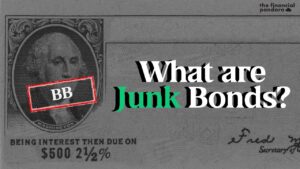So we are halfway through 2021 and two investment themes are continuing to play out in the financial markets: bond yields remain historically low and global equity markets are flying high. At time of writing, the yield on the 10-year US Treasury bond was a paltry 1.37% where the US Russell 2000 Stock Index was ahead 18%. Internationally, the Morgan Stanley All-Country World Index (which measures global stock market performance) is producing a healthy 2021 return of 12.24%. Commodity prices are also ahead by double-digits in 2021, with copper leading the way.
However, there is one area in the fixed-income (bond) market that is getting plenty of attention from investors in 2021: that is, junk bonds. ‘Junk bonds’ (often referred to as ‘high yield’ or ‘below investment grade credit’) are a type of bond issued by corporations that have much more risk tied to them than the average corporate bond. For example, the company issuing these types of bonds is often a newer, unproven firm, is smaller in size, has an uncertain revenue or earnings stream or operates in a specific industry (many junk bonds are issued by firms within the energy, metals and mining industries). All these factors cause the return on junk bonds to come with significant additional risk.
A bond is essentially a loan an investor makes to a company with the intent of receiving interest payments during the life of the bond and their principal returned when the bond matures. As such, why would an investor want to lend money to a riskier company as identified above, that has a chance of either not making timely interest payments or worse yet, default on the principal lent? One reason: junk bonds offer higher, and at times, much higher interest payments than corporate bonds that are considered to be investment grade and carry less risk.
Over the first 6 months of 2021 we are seeing something remarkable in the junk bond market that I feel should attract the interest of investors. As measured by the ICE B of A (Bank of America) High Yield Index and the Bloomberg U.S. Corporate High Yield Index (two junk bond benchmark indexes), the yields on junk bonds just hit a 25-year low of under 4%. What this means is that investors are searching so aggressively for high interest-bearing investments that corporations with higher risk are able to entice them with risky bonds that are producing very little in the way of interest. In fact, just recently, managed health care company Centene (ticker symbol: CNC) just set a new record low for perceived ‘high yield’ bonds with a recent issue of BB rated bonds priced to yield only 2.43%.
Another gauge of investor’s increasing appetite for junk bonds has been a tightening in what’s called the bond’s yield ‘spread’. A spread is the difference in yield that a junk bond offers in excess of a risk-free investment, which in this case would be a US Treasury bond of the same maturity term. Currently, this difference in yield spread is in the area of 300 basis points or 3%, which many analysts would describe as being very low or ‘tight’. In today’s ultra-low interest rate environment, a 3% spread between junk bond yields and comparable Treasuries sounds like a big difference, but historically it is extremely low. For example, during stressful economic conditions (ie. The Great Recession), junk bond spreads over Treasuries catapulted to 2,000 basis points or 20% by December of 2008.
Why are we seeing such a rally in junk bonds so far into 2021 when other areas of the bond market are flat to slightly down? Typically, through the concepts of duration and convexity, most bonds tend to move inversely with prevailing interest rates, which is what we are seeing so far this year in the Treasury and corporate bond markets. Given general market interest rates ticking slightly upwards to start the year, many bonds are down. However, what makes junk bonds interesting versus regular corporate investment grade bonds is how they respond to movements in two market forces: economic growth and interest rates.
Junk bonds returns are more closely tied to stock market returns than the return of the overall bond market. For example, when the economy is chugging along and interest rates begin creeping higher, junk bonds tend to keep increasing in value (vs typical bonds that begin declining in price). This is due to the fact that the corporation issuing these riskier bonds will be more likely to make interest payments on the bonds as the economy (and hopefully their individual business conditions) continue to improve.
However, when an economic downturn arrives, junk bonds tend to follow stocks and get walloped due to concerns that the issuing company may lack the cash flow to service their high-interest debt. Remember the Great Recession? At its height in November 2008, junk bond yields soared to 21.8% to compensate investors for the added risk they faced at this time.
Another interesting reason why junk bonds don’t move in tandem with investment grade corporate bonds is the way they are structured. Most junk bonds are priced with shorter maturities and with higher coupons than investment grade bonds. In the bond market, bonds that come with longer maturity dates and lower coupons are the bonds that are more highly sensitive to interest rates (in investing jargon, this is known as having higher ‘duration’). As such, simply by their structure, junk bonds are not as sensitive to interest rate movements that most bonds are.
In the financial markets, whether it be in stocks, bonds, commodities or real estate, overall sectors or industries that go up sharply over short periods often tend to fall to earth just as fast if not faster. Given that they are more tied to the economy and the performance of the stock market than the overall bond market, is now the time to have your investment portfolio overweight in this area?
I don’t believe this moment presents the opportune time for investors to either have a heavy portion of their long-term investment portfolio in the junk bond area or even worse, to be adding to their positions. Some analysts and economists have even indicated that the economy is ‘suffering’ from peak everything: Economic growth, corporate earnings growth and even fiscal stimulus (also known as quantitative easing or bond buying to positively influence the economy).
What we are seeing right now in the financial markets is a one-two punch of super-low interest rates and an economy that is riding high and taking the stock market along with it. Typically, one wants to add to their exposure in the riskier junk bond area when the economy and stocks have fallen back or better yet, at the height of a recession. This isn’t to say that more gains may be in the cards for junk bond returns in 2020 if the economy keeps expanding, but with record low rates being offered on newly issued bonds in this class, the big returns over the past year may be behind us.
What happened in the markets on Monday, July 19 is evident on how closely junk bond returns are tied to the economy and the stock market and how sharply and quickly the junk bond market can turn. Concerns about the new Delta variant of Covid-19 along with renewed tensions between the US and China and how those two events could affect the economy sent the stock market in the US reeling by over 2% with the Dow Jones declining over 700 points. What happened in the junk bond market? Spreads in junk bonds increased by 22 basis points (about 0.22%), a substantial one-day move, increasing their spreads over risk-free Treasuries securities to 344 basis points (about 3.44%).
Most advisors, depending on a client’s age, time frame and appetite for risk and return would recommend a 5% starting point for junk bonds in their portfolio. Given the healthy returns over the past year, some client weightings in junk bonds could be in the 7-8% area, which is not overly heavy, but just maybe due for a rebalancing back to the 5% or even 2.5% area.
Some more risk-seeking individuals may be tempted to take a look at an inverse junk bond fund, which tends to perform the opposite of its respective index or benchmark. One such product here is the ProShares Short High Yield ETF (ticker symbol: SJB). This investment, in theory, performs well when the junk bond market performs poorly, and vice-versa. However, with the way these products are constructed and perform (in particular, with ‘compounding risk’ in highly volatile markets), their returns rarely follow the inverse of the benchmark they are intended to replicate. In fact, they can even return extremely high negative figures, especially in volatile markets over longer periods.






